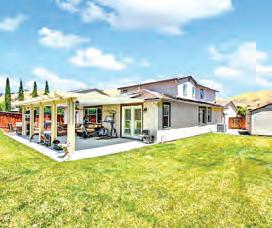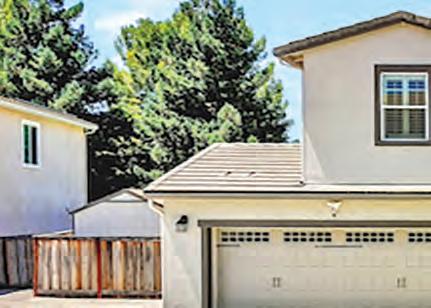
















































Q: I’m a tenant and a weekly reader of your column. I’ve noticed that you seldom answer questions from tenants but I’m hoping you’ll answer this one. My family and I rent a home in Suisun City. It’s a very old house downtown. Over the past several months a number of problems have cropped up in the house that the landlord won’t fix. Or at least hasn’t fixed despite our numerous requests. As an example, the roof in my daughter’s bedroom leaks. For tunately, it hasn’t rained too much, but still it leaks. The linoleum in the kitchen is in really bad shape and impossi ble to really get clean. There are several electrical sockets around the house that just don’t work. My son has no electricity in his bedroom. I’ve threatened the landlord that we are going to withhold the rent and he says if we do he’ll evict us. We are in the middle of a three-year lease. What should we do and how do we do it? Thanks.





A: To be honest, the reason I seldom answer questions from tenants is that I seldom get them. It seems that homeowners are much more likely to write in. So I’m happy to field your question.
Tenants have a number of remedies available to them when dealing with landlords who won’t fix problems in the home or apartment.
All of these remedies presume the tenant has given the landlord ample notice of the problem and a reasonable time to fix the problem.

The least serious is simply to fix it yourself and bill the landlord for the cost of the repair. In practice, you’d deduct the


amount of the repair from your


For example, if the bathroom sink was clogged, you’d inform the landlord. If he doesn’t get it fixed within, say, five days, you could call a plumber, pay the bill and deduct the amount you paid

This works for problems that don’t technically affect the hab-




isn’t much more than a month’s rent or so and that you can afford to pay the bill in the first place.
More serious problems, which translated means more expensive problems, can also allow the tenant to simply break the lease and move on the theory that the landlord has failed to live up to his contractual commitments.

However, withholding rent until a problem is fixed has got to be the most misunderstood remedy in the tenant’s arsenal and frequently gets tenants in trouble with the courts.
Withholding rent is only available when habitability issues are at stake. In this context, the word habitability has a legal meaning. It doesn’t mean that the paint is chipping or the microwave doesn’t work.
See Jones, Page 9
is unique and well-equipped property o ers a blend of serene countr y living and modern conveniences, making it an exceptional place to call home. As you enter, you’ll be greeted by a grand cathedral ceiling in the entr yway, setting a tone of elegance and spaciousness. e attention to detail is evident throughout the property. is property o ers ample storage space with a 20x10 Tu Shed, providing room for all your tools, equipment, or hobbies. In addition, a detached twocar garage with a nished interior o ers even more storage options. For those with a love for animals, this property features dedicated livestock yards for your furr y friends, as well as two separ ate fenced dog runs to keep your dogs safe and happy. A 2-stall barn o ers the possibility of expanding to 4 stalls, providing an ideal space for horses or other livestock. e at and usable land o ers endless possibilities for outdoor activities and expansion. Enjoy breathtaking views of the surrounding countr yside, creating a tranquil and picturesque environment. is quiet property allows for peace and privacy while conveniently close to town for shopping, dining, and other amenities. Easy freeway access ensures e ortless commuting and travel.
Offered at $799,000







When you’re buying a home, the sale can fall through for many reasons. But what if you just change your mind? If you’re in contract to buy a home but are having second thoughts and want to back out of your accepted purchase offer, things can get complicated. When is it too late to back out of buying a house?
It’s not impossible for a buyer to back out of a signed real estate contract with a seller, but there could be repercussions – especially if no escape hatches were included in the deal. Understanding your financial and legal rights as a homebuyer is critical. Here’s what to consider if you’re thinking about rescinding an accepted offer.
The short answer: yes. When you sign a purchase agreement for real estate, you’re legally bound to the contract terms, and you’ll give the seller an upfront deposit called earnest money. Your earnest money deposit shows the seller that you’re serious about your intention to purchase the house and plan to follow through on the agreement.
“It’s not fair to the seller to pull their home off of the market if a buyer is not totally serious,” says Marc Hagerthey, a real estate agent with RE/MAX in Maryland. “The earnest money will sit in an escrow account and will be used to pay a portion of the closing costs at settlement.”
However, putting certain contingencies in place makes it perfectly legal to withdraw your
If a homebuyer backs out of a sale for a reason that’s not specifically stipulated in the contract, however, things can get tricky –and potentially ugly. Backing out of an offer for a non-contingent reason means you risk losing your earnest money. Since you put that money down based on the promise that you would follow through with the contract, backing out for any reason that’s not outlined in the agreement means the seller is legally permitted to keep your money.
offer on a house after it’s accepted if those contingencies are not met. These restrictions, which will be built into the contract, spell out situations in which backing out without penalty would be acceptable. In most cases, you’ll get your earnest money back.
A standard real estate contract typically comes with a number of contingencies – these are the conditions that must be met in order for you to move forward with a home purchase. This includes a mutual agreement of specific tasks that have to be completed within a certain time frame.
Homebuyers might include
contingencies for the home inspection, securing financing with their lender, selling their own home first or the home appraising for less than the sale price. If you back out of an offer because an agreed-upon contingency failed to be met, you can do so with little fuss and still get your earnest money deposit back. A buyer usually has more protection when walking away from a deal if contingencies are in place. For example, let’s say a home inspection report comes back and there are costly issues, such as a damaged roof that needs to be replaced or cracks in the foundation. With a home inspection contingency in place, you can walk away from the deal – especially if the seller refuses to fix the problem or offer credits to offset the costs. Another important safeguard is a financing contingency,
which gives you an out if your lender doesn’t pull through with a loan approval.
To protect yourself, pay careful attention to the contingencies outlined in the agreement, and especially to the deadlines attached to each. For example, you might be required to complete a home inspection (and ask for any repairs/credits) within 14 days after the contract is assigned. A financing contingency might need to be met within 30 days to get final loan approval. If you’re not sure about something or you need more time to complete a contingent task, ask your real estate agent. They will likely need to file a contract addendum that the seller must approve to get your extension.
This can be prohibitively costly for a buyer, especially if they still hope to buy a different house. Earnest money deposits typically run around 1% or 2% of the home’s purchase price, and sometimes more. So, on a $300,000 home, a buyer with cold feet could stand to lose between $3,000 and $6,000, plus legal fees.
Again, the short answer is yes. If you back out of a signed contract for a reason not explicitly stipulated as a contingency, not only do you risk losing your earnest money, but the seller could possibly seek further legal action. It’s easier to back out of buying a house before the purchase agreement is signed. If you decide to exit after that point, or after the contingency periods have expired, you’ll have a much harder time doing so without landing in legal or financial trouble.
A buyer in breach of contract could potentially be sued for what’s called “specific perfor-


Ayard is nice, but a welldesigned patio can make an outdoor space really sing. Infinitely customizable, they’re great spots to grill, chill, entertain and exercise. They’re low maintenance, requiring little more than the occasional sweeping or power washing. And given that they’re typically made of flagstones, bricks or pavers, they’re incredibly durable; once you’ve built one, you should be able to enjoy it for decades.
Best of all for DIYers, they’re budget-friendly and relatively easy to build – a modest one will only take a weekend’s worth of work. Then you can start enjoying your new space, whether it’s with an alfresco dinner, a spirited game of Catan or some muchneeded alone time with a hot read and a cold cocktail.
Cathy Carr, founder and principal garden designer of GreenHeart in Silver Spring, Md., says every patio project should begin with the question, “Why am I building a patio?” Is it a showy space to host barbecues and family get-togethers, a soothing area where you do yoga or read, or a place where kids run around and play games? Identifying the purpose will help you determine its size, aesthetic and design. To keep the project on the simpler side and lessen your workload, Bill Millholland, executive vice president of Case Architects & Remodelers in Bethesda, Md., recommends choosing a flat area of your property. Also keep in mind how much sun and shade the location receives as that can impact the enjoyment of the patio.
Though building a patio can be a solo project, Amy Hovis, owner of Eden Garden Design in Austin, thinks it’s best done by two people given the weight of the building materials and the physicality of the work. Shovels, picks or mattocks, and a wheelbarrow are best for clearing the ground. A manual tamper or a plate compactor is necessary to pack down the base. Have a level, stakes and string on hand to help define and level the patio. Additionally, Millholland suggests having a rubber mallet to properly set pavers, bricks, flagstones and other elements.
Start by using stakes and string to define the area and
install an edging, such as pressure treated two by fours, steel or paver stones, Hovis says. Remove any plants or grass. Excavate a shallow depression within the defined space, roughly four to six inches deep to accommodate both the base and surface materials. Compact the dirt on the bottom using a hand tamper, then add two to three inches of crushed gravel and compact it. Finally, add two to three inches of sand and compact that.
The base layer needs to be leveled with a slight angle downward, away from your home or other structures. “You want it about an eighth of an inch a foot,” Carr says of the slope. “That’s enough so the water drains
away, but not so steep your furniture will look like it’s tilting.” The easiest way to do this is the screed method, which involves placing lengths of one-inch wide rounded or square metal piping on either side of your base and then running a long two-by-fourinch board back and forth across them to achieve the proper leveling. Depending on the width of your patio, you may need to do this in stages. Finally, fill in any dips in the sand to ensure a completely flat surface.
All this digging is going to displace a lot of dirt, so there needs to be a disposal plan. “If you have a low spot in the yard, you can spread it there and sprinkle it with grass seeds,” Millholland
says. “Or you can build a berm to give height to some element of your garden.” Otherwise, you’ll be hauling all that terra firma to the dump or paying someone else to take it away.
Bricks and concrete pavers are the easiest patio materials to use because they have a uniform shape and create a relatively flat surface. That’s helpful if you want to roll a grill across it, put down a mat to do Pilates or wear high heels while hosting a dinner party. First-timers should consider designing a patio that doesn’t include any curvy or custom-size elements, which would involve cutting masonry materials. This requires specialized equipment and can be challenging.
Another surface option: flagstones. They are beautiful, but they can be tough for beginners because they are irregularly sized and have varying thicknesses, making them difficult to arrange. “It’s like a jigsaw puzzle fitting all the pieces together,” Millholland says. Hovis suggests using locally sourced flagstone to get a better match with your natural surroundings and avoid environmentally unfriendly longdistance shipping.
Once the patio’s surface is arranged to your liking, Carr recommends filling the gaps with either sand or stone dust to ensure things don’t shift and to stunt weed growth. After you’ve poured the filler, use a broom to sweep in any excess, then use a hand tamper to help settle it further. You may need to repeat
See Patio, Page 5



Ihesitate to even bring this up again because I was fooled April 1st when I told all my readers and Realtor partners about the greatest down payment assistance program in history.

Our California Housing Financing Agency, or CalHFA, representative told me that they expected the $300 million to last at least 90 days. When I told the CalHFA person that based on the guidelines, I thought it might sell out in a month, her response was, “we certainly hope not.” It was gone in less than 10 business days.


CalHFA announced a couple of weeks ago that another $200 million worth of Dream for All funds will be coming in the fall, and new guidelines will be coming, too, with no other details.


The first batch of 20% down payments were gobbled up by a ton of buyers in the higher-end markets who took advantage of the incredible shared-appreciation program. Dream for All gave first-time homebuyers a 20% down payment with no cap on sales price or income limits for buyers who made up to $215,000 in Solano County, and substantially more in counties like Marin, San Mateo and Los Angeles.
Local Realtors and lenders helped a few lucky Dream for

Editor’s note: Solano real estate transactions were not available this week.
Jim Porter
All buyers. The maximum firstmortgage amount was only $720,200, but this allowed a buyer with $80,000 in cash to buy a house for $1 million and use that $80,000 plus the $200,000 from the state to avoid PMI and obtain a 30-year fixed-rate $720,000 loan with a payment of only $4,450 per month, which saved this firsttime homebuyer more than $1,700 per month.

Many of these first-time homebuyers were already preapproved to buy a house without the down payment assistance, but who in their right mind would turn down a $200,000 loan that required no payments or interest for 30 years in exchange for 20% of the equity that might exist when they sell the home?
These super-smart firsttime buyers could invest the $1,700 savings per month for the 30 years and get 9% on their money in the stock market and would have $3.1 million in their brokerage account. Assuming the $1 million home tripled in value in 30 years, all they would have to pay is $400,000 plus the
From Page 4
these steps to completely fill the gaps. Use concrete or polymeric sand for more durability. Just don’t let either of these materials sit on your paving surface, as they may stain
$200,000 out of their $3.1 million sitting in the bank. (That’s a $2.5 million profit.)
This was the biggest no-brainer in the history of firsttime homebuyer programs, but it did very little for the thousands of buyers who needed this the most in Solano and Yolo counties, because the guidelines were so broad that the coastal-city market Realtors and buyers jumped for joy. Over my last 40 years in the business, income-based down payment assistance programs have almost never been available for home prices above $720,000 and usually only help folks looking below $600,000.
Dream for All is coming in the fall, but for first-time homebuyers today, CalHFA has down-payment money right now for buyers who make less than $215,000 per year to buy a house with zero down.
Jim Porter, NMLS No. 276412, is the branch manager and senior loan adviser of Solano Mortgage, NMLS No. 1515497, a division of American Pacific Mortgage Corporation, NMLS No. 1850, licensed in California by the Department of Financial Protection and Innovation under the CRMLA / Equal Housing Opportunity. Jim can be reached at 707-449-4777.

or stick to it.
The proper plantings can transform a basic patio. Carr has a few ideas: Plant a hedge around it to create a private oasis; put in an adjacent herb garden so you can add fresh seasonings as you grill; or use flowers to bring pleas-
ing fragrances to the area. “Always plant something for movement, such as grasses,” adds Hovis, who advocates for only using native species. “Even if it’s a hot day, when you see the breeze catch the plants it feels a lot cooler than it may be and it’s just a wonderful sensory component.”






















From Page 3







mance,” in which the court forces the buyer to close on the home. However, this scenario is not very common. “It’s pretty rare that this happens,” says John Graff, CEO of Ashby & Graff Real Estate in Los Angeles. “You’re more likely to see the courts ordering a seller to close a sale, not the other way around.”
In some states, home purchase agreements have a clause that requires both parties to agree to



mediation if there is a dispute. That means you’ll have a chance to plead your case to the seller directly, with the help of a neutral mediator – and, hopefully, resolve the issue outside of a courtroom.







Buying a home is a serious commitment and shouldn’t be taken lightly. It is possible for a buyer to back out of a signed real estate contract with a seller, but there may be serious consequences. The best way to protect yourself is to build contingencies
into the contract upfront, before signing. Working with an experienced real estate agent, and possibly a real estate attorney as well, can be crucial here.

If you do need to back out of an accepted offer, be honest with the seller as soon as you’ve made your decision. Work closely with your agent and attorney, who can help you communicate (in writing) why you want to back out. Ultimately, you may lose your earnest money deposit – but buying a home you don’t want or can’t afford would certainly be a more expensive mistake in the long run.


FRUSTRATED with your current Lender fumbling your Purchase or Refinance, Bring your loan to us so we can get you locked at a GREAT RATE and Finish it up QUICKLY! We don’t mess around, We Get it DONE, We are Local and we DELIVER!
When we write your Pre-Approval Letter to present to the seller, You WILL Close the Deal with us!
















707.759.5129



We can use ANY Bank or Investors Wholesale dept. We are not confined to just one source. Why have 5 banks pull your credit, when we can pull it once and get bids for you from 5 banks??


1300


















qualifies as does the lack of electricity in a bedroom.
in the middle of summer, it might not reduce the rent at all.
If you decide to withhold rent, the first decision you have to make is how much to withhold. Technically, you should only withhold that amount which would reduce the rent to the actual rental value of the property in its current condition.
How do you know what the reasonable rental value is? I don’t know. Basically you make a good faith guess.
lord just might file an eviction lawsuit, called an unlawful detainer, to try and get you out for not paying the rent.
strated by depositing the money into the bank account, it will go a long way toward helping your argument.
A short list of habitability issues include a property with toxins (e.g. lead or chemicals), inadequate sanitation, ineffective waterproofing (e.g. leaking roof), lack of running water, bad electrical system, inadequate natural light and ventilation, and any other serious safety issue.
The above list isn’t comprehensive, but you get the idea.
Certainly your leaking roof
If the rent is $2,500 per month and the furnace is broken during the winter, the rental value may be only $500 and you’d be justified in withholding $2,000 per month.
If the same problem occurred
Once you’ve made your guess you notify the landlord in writing that you will be withholding, in my example, $2,000 per month until the problem is fixed.
Although the law doesn’t require it, it is good practice to then put the $2,000 per month into a special bank account you’ve opened for that purpose. That’s because the land-
During eviction trials, judges hear from tenants all the time that they were just withholding rent, when in fact they just didn’t have the money to pay the rent.
If you can show the judge you weren’t refusing to pay the rent because you couldn’t, as demon-
From Page 2 THE DAILY REPUBLIC DELIVERS. CALL 707-427-6989.
Tim Jones is a real estate attorney in Fairfield. If you have a real estate question you would like answered in this column, you can send an email to AllThingsRealEstate@ TJones-Law.com.
There’s nothing quite like Pink Cashmere to put the happy face on a summer that has turned oppressive from heat and humidity.
No, this is not part of The Garden Guy’s watering wardrobe, but a new Superbena verbena making its debut in 2024.
The past three years, Superbena verbenas have steadily climbed the lists of the most popular butterfly plants at The Garden Guy’s house. Varieties like Cobalt, Stormburst, Whiteout and Royal Chambray can hold their own with a lantana any day of the week when it comes to bringing in pollinators.


Immediately Pink Cashmere showed it had the same habit and toughness we’ve come to expect with Superbena verbenas. Mine were planted in April and are performing like an award-winner as we turn toward August.
Pink Cashmere is kind of an apple blossom color to me, with shades of dark and light pink and some white florets. The blooms are large, the foliage vigorous and disease-free. Best of all, the blooms are always being shown affection from hummingbirds, bees and butterflies like eastern tiger and spicebush swallowtails.
The plants will reach about 12 inches tall and have the potential of a 30-inch spread. This means you can use them thriving as a floral carpet-like groundcover, tumbling over walls or the rim of containers, or plummeting from baskets.
When you get yours next spring, choose a location with plenty of sunlight. The soil should be fertile, organic-rich and freely drained. This is why they are so easy to grow in con-
tainers, since you use potting soil. Prepared landscape mixes and planting on raised beds help duplicate this environment in the landscape.
Space your plants 10 to 14 inches apart if you are going to plant an informal drift or sweep in the landscape. Use an application of controlled release granules at planting again in midsummer.
Those I received for trial purposes were used in window boxes and containers. Controlled release granules were used at planting and then a switch to water-soluble feeding since watering is a daily regimen.

One growing technique that has proven itself time and again when I was with Mississippi State University and in my own garden is proactively cutting back. In the hot, humid South, we all go through those times
when verbenas look tired, open and generally unproductive.
This is a great time to cut back by a third and feed with a water-soluble fertilizer. Generating new growth means more of those incredible blossoms. In containers, The Garden Guy likes to feed with a dilute water-soluble mix about every two weeks. The response is almost magical.
Superbena Pink Cashmere offers so many plant partnership possibilities. In my containers I partnered with the new yellow Supertunia Saffron Finch petunia, also making its debut in 2024. There is something special about the soft yellow and pink together.
In the window box we used Superbena Pink Cashmere verbena with Unplugged So
See Winter, Page 11
From Page 10

Blue salvia, Supertunia Saffron Finch petunia, Supertunia Mini Vista Sweet Sangria and Supertunia Mini Vista Indigo petunias, which turned out nothing short of stunning.
The Garden Guy has always been a flaming orange kind of guy, but Superbena Pink Cashmere has convinced me I need some pink in my garden, too! I imagine it will be a competitive spring at the garden center, so get ready to elbow your way to the table where Superbena Pink Cashmere will be on display.
Norman Winter is a horticulturist, garden speaker and author of “Tough-as-Nails Flowers for the South” and “Captivating Combinations: Color and Style in the Garden.”

Huge Price Reduction! New Price $1,648,000


This beautiful single level 3290 sf home includes 3BR/3.5BA plus 2 bonus rooms, a den and an outside bathroom. It has been meticulously updated with attention to detail. Rich hickory flooring throughout. Custom kitchen with large Quartzite countertops and six-burner cooktop. New vanities and countertops in the bathrooms, laundry room. New lighting and custom audio inside and in the backyard. New HVAC, upgraded alarm system. Sparkling heated salt-water pool and hot tub are both Wi-Fi operated. Built-in BBQ & bar, new deck and patio, bistro lighting and LED accent lighting, including eaves of the house. Dog run with custom iron gate, and a 10x12 shed with sink and toilet. Private and serene yard is an inviting place to enjoy family living. With over $580,000 in recent updates/upgrades, there are simply too many items to list.
Open House Sunday, 12:00-4:00




Loney & Worley Team invites you to join us at 4829 Duval Street in Paradise Valley-Fair eld









Welcome to Paradise! This is a highly sought after floor plan that is located in Paradise Valley and sits on the fourth fairway of the golf course. The primary bedroom and bathroom are located on the first floor and look out to the golf course. There is 2 additional first floor bedrooms. The upstairs has it’s own separate section that could easily be used as a separate apartment/living space. Upstairs offers a fourth bedroom, bathroom and great room. The kitchen has been completely updated. Newer stainless steel appliances, 5 burner gas cook-top with vent hood. Newer granite counter-tops, large island with dual stainless steel sinks. Kitchen opens to a large great room that looks out to views of the fourth fairway on the golf course. Newer updated flooring, high ceilings & crown molding throughout the home. In-door laundry room. Covered patio in backyard is upgraded type insulated (quiet during rain and less hot penetration during heat). Garage door is also insulated. Close to Paradise Valley Clubhouse, golf course and community park. This home also has 21 solar panels. Exterior & interior was recently painted. There are drafted plans available to review for 2 possible ADU’s to be added and/or a pool. Added bonus, there’s NO Home Owners Association fee’s in The Enclave Offered at $899,000
Fully hosted by Loney & Worley Team

Scott C. Loney (707) 290-0556 Lic#01146887 • Alicia N. Worley (707) 344-1300 Lic#01322884



Saturday & Sunday 12:00 PM-3:00 PM 2280

“Your Local Top Producers with Over 28 Years each in the Real Estate Industry-Luxury Estates, Wineries, Vineyards, Commercial, Developments and Residential Sales.”
